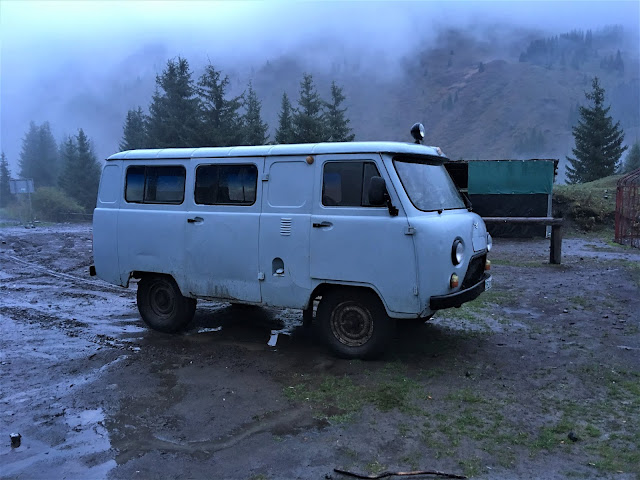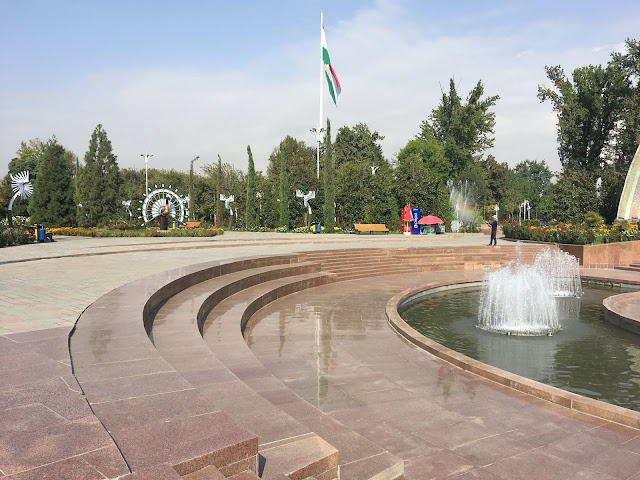CENTRAL
ASIA ADVENTURE – PART II
There comes a time in each of these adventures when
you ask yourself: “What the hell am I doing here?” We drove two and a half
hours from Karakol to the Kazakhstan border in the pouring rain, the last half
over a very rough gravel road. We crossed the middle-of-nowhere border on foot,
dripping wet, and boarded the buses again. First impressions of Kazakhstan were
not that great: a ten-kilometer jounce through the ditch beside an unfinished
road. Fortunately, things got a bit better as we neared our destination for the
night, a guest house in Saty village.
The highlight of the day was an off-road drive into
Kolsay Lakes National Park followed by a hike to Kaindy Lake, known as the
sunken forest. The lake was formed when a 1911 earthquake triggered a massive
limestone landslide that formed a natural dam. We climbed into a Soviet-era
four-wheel-drive, parked our butts on benches, and hung on for dear life on the
roughest ride I can remember. One hour later, we ground to a halt in a parking
lot and hiked the rest of the way to the lake. As these views show, the drive
was worth it. Back down in the village, we feasted on a home-cooked meal and
settled in for the night.
So far on this trip, we’ve stayed in three types of accommodations: hotels, yurt camps, and guest houses. Yet to come are a home stay and a night in a tent. Guest houses are like B&Bs. In Saty, we stayed with a three-generation family that has been welcoming guests for ten years. Sixteen of us shared one bathroom but there was wifi! What struck me about this scenario was the spirit of entrepreneurship displayed by the family. They realize that improvements are required, so they’re expanding with rooms that will have full baths. Think about how far they’ve come. Not even seventy years of Soviet oppression could kill their desire to work hard and make a better future for themselves.
So far on this trip, we’ve stayed in three types of accommodations: hotels, yurt camps, and guest houses. Yet to come are a home stay and a night in a tent. Guest houses are like B&Bs. In Saty, we stayed with a three-generation family that has been welcoming guests for ten years. Sixteen of us shared one bathroom but there was wifi! What struck me about this scenario was the spirit of entrepreneurship displayed by the family. They realize that improvements are required, so they’re expanding with rooms that will have full baths. Think about how far they’ve come. Not even seventy years of Soviet oppression could kill their desire to work hard and make a better future for themselves.
Between Saty and Almaty, we hiked in Charyn Canyon.
Although smaller than the Grand Canyon, it has been described as being equally
impressive (probably by someone who hasn’t seen the Grand Canyon). Still, we
had a nice walk and, best of all, had the place to ourselves.
Kazakhstan is the richest of the five Stans,
boasting significant reserves of oil and natural gas, and a wealth of mineral
resources. In terms of land area, the country ranks ninth, bigger than Algeria
and smaller than Argentina. The average monthly salary is $600 CDN, three times
that of Kyrgyzstan. Although we spent only two days in the country, it was
enough to show that it’s on the move economically. The largest city, Almaty, looks
and feels very European. It features wide boulevards, pedestrian malls, a
modern university, a subway system, and a strong café culture. The contrast
between urban and rural is huge though. In terms of development, there is a
fifty-year gap between the two.
After spending the night in a four-star hotel, we
flew from Almaty to Dushanbe, capital of Tajikistan. We said goodbye to five of
our fellow travellers and welcomed others from Malta, Alaska, and Toronto,
along with our new G Adventures Chief Experience Officer (CEO), Aktilek (AK).
The luxurious four-star Atlas Hotel was quite impressive for such a poor
country. But, as we were about to find out, Dushanbe looks anything but poor.
The President, Emomali Rahmon, in effect the supreme
leader, came to power in 1994, three years after the country declared its
independence. Credited with stopping a civil war and preventing the country
from becoming an Islamic republic, he seems much loved by the population though
it’s hard to tell whether the reverence is genuine. Suffice to say that his
likeness is everywhere and his handlers are very accomplished users of
Photoshop. Dushanbe is clearly the jewel of the nation and boasts
infrastructure and public buildings far more impressive than what we saw in
Bishkek, capital of Kyrgyzstan.
We toured the city with our local hosts, Panjakent Intour, led by its owner, Farid. We stopped first at a mosque, then walked around the central square, visited the National Museum of Antiquities, and browsed the impressive city market.
We toured the city with our local hosts, Panjakent Intour, led by its owner, Farid. We stopped first at a mosque, then walked around the central square, visited the National Museum of Antiquities, and browsed the impressive city market.
From Dushanbe, we headed north through the magnificent Fann Mountains destined for our home stay in Saritag, near Iskanderkul. Iskanderkul (Lake Iskander) is named for Alexander the Great, the Macedonian conqueror, who passed through the area in the fourth century B.C. The road to the lake is off-road standard, similar to some of the tracks we travelled on in Kyrgyzstan. Just when we thought we couldn’t go any further, the road somehow kept going. Up the face of the mountain we went, bouncing from one pothole to another, around switchbacks and, finally, through the high alpine village of Saritag. Our homestay was higher up the valley still, basically at the end of the road. As we approached it, the two-storey house looked like something out of a fairy tale. The dormitory-style rooms were to be our home for the next two nights.
Our group was the last of the season. Because the
homestay had no central heating, we had to bundle up and sleep fully clothed,
just as we had in the yurts. Next morning, the sun greeted us as we hiked up
the valley, following the route of shepherds and their families who spend their
summers in primitive stone houses. It was breathtakingly beautiful.
 In the late afternoon, our guides drove us into the
village where we had tea at another homestay and learned about Tajik culture
and values. As different as these people appear to be from us, their strong
system of values bears many similarities. We found ourselves thinking back to
the time of our grandparents, realizing that we have much in common. We walked
around Saritag in the pouring rain, taking in the sights, sounds and smells of
this village of 400, meeting the people as we went. It’s a way of life that’s
destined to change, for better or for worse.
In the late afternoon, our guides drove us into the
village where we had tea at another homestay and learned about Tajik culture
and values. As different as these people appear to be from us, their strong
system of values bears many similarities. We found ourselves thinking back to
the time of our grandparents, realizing that we have much in common. We walked
around Saritag in the pouring rain, taking in the sights, sounds and smells of
this village of 400, meeting the people as we went. It’s a way of life that’s
destined to change, for better or for worse.After a cold night in the homestay (I wore two sweaters!), we drove back down the valley and headed north toward Khujand, the country’s second-largest city. On the way, we stopped for a panoramic view of Iskanderkul, a landscape equal to anything we’ve seen in the Canadian Rockies, the Alps, or the Pyrenees.
Tajikistan is 90% mountains. The nine million people
who live in the country occupy the valleys, most of them quite favourable to
agricultural production. On the way to Khujand, we stopped in Istaravshan for a
visit to a mosque and a reconstructed fortress. In Khujand, we toured the
museum and drove to our lodging for the night, the Firuz Hotel.
Next morning, we drove to the Uzbekistan border
after spending time in Khujand’s vast central market. We said goodbye to Farid (on
the left in the photo) and our excellent driver, Abdul (center) and walked the
kilometer or so across the border to country number 78 on our list.
Two days in Kazakhstan were far too little to give
us a taste of that vast country. The five days we spent in Tajikistan were just
enough. Half-way through our Central Asian adventure, we’re quite pleased with
what we’ve seen so far. Our experiences have been genuine, we’ve met the locals
on many occasions, and we’ve gone to places only accessible to those who know
how to get there. We’ve found the people friendly and unfailingly polite, and
we’ve never felt unsafe or harassed. People here understand the meaning of
service and that they will not be able to build a tourism industry without it. But
they do have a long way to go; it takes more than effort to make a satisfied
customer.
Every morning, we start the day by reminding ourselves how lucky we are to be able to see these wonderful places and enjoy quality time together!
Every morning, we start the day by reminding ourselves how lucky we are to be able to see these wonderful places and enjoy quality time together!

















No comments:
Post a Comment